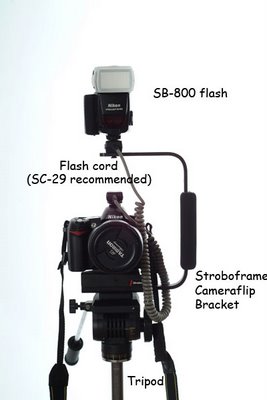Flash Brackets
In some of my earlier posts here in this blog, I've mentioned the use of a flash bracket to keep the flash in a vertical line with the lens when shooting portrait orientation photographs (that's long way up and down for those of you who were wondering). I dislike the side shadow that happens when you don't keep the flash in line with the lens, and the flash bracket is a good way to make shadows fall behind the person, not to the side. Plus, a flash braket really reduces the risk of red-eye by raising the flash. So tonight's post is a brief description of the kinds of flash brackets that are out there and what you're going to need to make the bracket work for you.In the most basic forms, flash brackets come in two types: A) a bracket where the flash rotates or B) a bracket where the camera rotates. Each has advantages and disadvantages, which you will have to consider before you plunk your hard-earned cash down and buy a bracket.
I'm going to take a look at type B) first, primarly because I have some photos to put up here. To me, one of the biggest advantages of the camera rotating bracket is the ability to put the camera on a tripod. For some applications, such as posed photos for mixed individuals and groups, the use of a tripod can be invaluable.
So, here's the photos showing how a camera rotating bracket works:



Notice that in order for the flash bracket to work, there must be a cord in the camera hot shoe which also attaches to the flash bracket itself. This allows the camera to trigger the flash, even though it's not in the camera hotshoe--the cord itself acts as extension of the camera hot shoe. So when you buy a flash bracket, you've also got to buy a cord. And if you want your fancy-schmantzy flash to work in its specialized modes like Through The Lens (TTL) flash metering, you've got to buy a special cord dedicated to your camera model and flash.
Now, the other type of flash bracket is one where the flash rotates. In this scheme, the photographer turns the camera to the portrait orientation and rotates the flash so it sits vertically above the lens. This type of bracket really can't be mounted onto a tripod, so it's really aimed at a photographer who needs to move around. It also needs a flash cord to work properly too.
One disadvantage of the flash rotating bracket is that for some models, the shutter release ends up on the bottom of the camera. I myself don't find this to be a problem, but some photographers prefer the shutter release to be on top in portrait orientation. And if your camera has a vertical grip with release, buying the wrong bracket can make the vertical release pretty useless.
Of the two types of bracket, I find it easier to zoom and focus with a flash rotating bracket. It's easy for me to support the whole bracket with my left hand while zooming with my right. With camera rotating brackets, I find that the right hand has to always be on the camera, but that gripping the camera doesn't feel like a secure way to hold the whole contraption while zooming. If I need to shoot on a tripod with a bracket though, the camera rotating bracket is the only way to go.
There are modifications to the camera rotating bracket on some models, like a padded grip which allows the photographer to hold the bracket with the palm of the left hand while zooming with the left-hand fingertips. However, these brackets are large and heavy too.
Besides a flash cord, you might also need something to keep your camera from rotating on the bracket. What happens is that the camera is attached to the bracket via the camera tripod socket, but often there's enough play that the camera can "twist" on the bracket. To prevent this you may need a soft cushion on the bracket like cork or a special piece of metal called an "anti-twist plate."
Something else to be aware of: flash cords are often too long, so you end up winding them around the bracket and securing them with twisty ties or some other mechanism. Some people cut the cords and splice the wires back together, but that's too much work for me. Plus, what if I want a long cord someday?
The interesting thing is that walking around with an SLR on a flash bracket really marks the photographer as really serious and professional. People who wouldn't look at me twice if I had an SLR suddenly are in awe of my apparent professional status because I have a camera and flash attached via a bracket. Never mind that these people have never seen a photo I've taken or know what I do for a living--just seeing the camera and flash on a bracket is enough. So, if you need to compensate for photographic inadequacies--in more ways than one--get yourself a flash bracket and prepare to be amazed.

1 Comments:
zzzzz2018.8.2
nike shoes for women
moncler online outlet
oakley sunglasses
manolo blahnik
coach outlet
adidas nmd
oakley sunglasses wholesale
air jordan 4
polo lacoste
christian louboutin outlet
nike shoes for women
moncler online outlet
oakley sunglasses
manolo blahnik
coach outlet
adidas nmd
oakley sunglasses wholesale
air jordan 4
polo lacoste
christian louboutin outlet
Post a Comment
<< Home